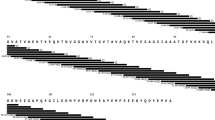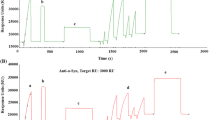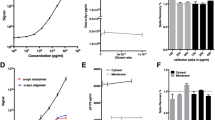Abstract
In the present study, we detected the level of oligomeric form of α-synuclein in the red blood cells of ischemic stroke, Parkinson’s disease, and normal people and compared the differences to assess the diagnosis potential of α-synuclein in ischemic stroke patients. 86 ischemic stroke, 100 PD, and 102 healthy cases were enrolled in the present study. Total protein amount in the red blood cells were quantified by BCA assay using spectrophotometer. Levels of oligomeric form of α-synuclein were characterized by a sandwich ELISA. Analysis of correlation analysis and receiver operating characteristic curve were conducted. Significant differences were detected in the levels of oligomeric forms of α-synuclein in different samples’ blood cells (P < 0.05); the levels of total protein in (188.1 ± 33.9 mmol/L) healthy people were significantly higher than that of PD (147.7 ± 45.0 mmol/L) and ischemic stroke groups (142.9 ± 43.0 mmol/L) (P < 0.05). There was no correlation between the age of patients and level of α-synuclein (R 2 = 0.216 in ischemic stroke group and −0.104 in PD group) and the receiver operating characteristic curve analysis showed a high sensitivity of α-synuclein in discriminating ischemic stroke (sensitivity was 63.7 % and specificity was 9.6 %) and PD (sensitivity was 44.1 % and specificity was 12.5 %) patients from the controls. The levels of oligomeric form of α-synuclein of red blood cells in ischemic stroke and Parkinson’s disease patients were both significant higher than normal people. And the level of oligomeric form α-synuclein showed a potential for diagnosis of ischemic stroke in clinic.



Similar content being viewed by others
References
Morgante L, Salemi G, Meneghini F, Di Rosa AE, Epifanio A, Grigoletto F, Ragonese P, Patti F, Reggio A, Di Perri R, Savettieri G (2000) Parkinson disease survival: a population-based study. Arch Neurol 57(4):507–512
Guttman M, Slaughter PM, Theriault ME, DeBoer DP, Naylor CD (2001) Parkinsonism in Ontario: increased mortality compared with controls in a large cohort study. Neurology 57(12):2278–2282
Driver JA, Kurth T, Buring JE, Gaziano JM, Logroscino G (2008) Parkinson disease and risk of mortality: a prospective comorbidity-matched cohort study. Neurology 70(16 Pt 2):1423–1430. doi:10.1212/01.wnl.0000310414.85144.ee
Elbaz A, Bower JH, Peterson BJ, Maraganore DM, McDonnell SK, Ahlskog JE, Schaid DJ, Rocca WA (2003) Survival study of Parkinson disease in Olmsted County, Minnesota. Arch Neurol 60(1):91–96
Godwin-Austen RB, Lee PN, Marmot MG, Stern GM (1982) Smoking and Parkinson’s disease. J Neurol Neurosurg Psychiatry 45(7):577–581
Noyce AJ, Bestwick JP, Silveira-Moriyama L, Hawkes CH, Giovannoni G, Lees AJ, Schrag A (2012) Meta-analysis of early nonmotor features and risk factors for Parkinson disease. Ann Neurol 72(6):893–901. doi:10.1002/ana.23687
Spillantini MG, Schmidt ML, Lee VM, Trojanowski JQ, Jakes R, Goedert M (1997) Alpha-synuclein in Lewy bodies. Nature 388(6645):839–840. doi:10.1038/42166
Maroteaux L, Campanelli JT, Scheller RH (1988) Synuclein: a neuron-specific protein localized to the nucleus and presynaptic nerve terminal. J Neurosci 8(8):2804–2815
Nakajo S, Omata K, Aiuchi T, Shibayama T, Okahashi I, Ochiai H, Nakai Y, Nakaya K, Nakamura Y (1990) Purification and characterization of a novel brain-specific 14-kDa protein. J Neurochem 55(6):2031–2038
Eschbach J, Danzer KM (2014) α-Synuclein in Parkinson’s disease: pathogenic function and translation into animal models. Neurodegener Dis 14(1):1–17. doi:10.1159/000354615
Barbour R, Kling K, Anderson JP, Banducci K, Cole T, Diep L, Fox M, Goldstein JM, Soriano F, Seubert P, Chilcote TJ (2008) Red blood cells are the major source of α-synuclein in blood. Neurodegener Dis 5(2):55–59. doi:10.1159/000112832
Chen YD, Li X, Yang W, Li X, Yu S (2013) Changes of α-synuclein and its oligomeric formation in plasmas of patients with stroke. J Capital Med Univ 34(6):826–829
Unal-Cevik I, Gursoy-Ozdemir Y, Yemisci M, Lule S, Gurer G, Can A, Muller V, Kahle PJ, Dalkara T (2011) Alpha-synuclein aggregation induced by brief ischemia negatively impacts neuronal survival in vivo: a study in [A30P]α-synuclein transgenic mouse. J Cereb Blood Flow Metab 31(3):913–923. doi:10.1038/jcbfm.2010.170
Huang YP, Chen LS, Yen MF, Fann CY, Chiu YH, Chen HH, Pan SL (2013) Parkinson’s disease is related to an increased risk of ischemic stroke-a population-based propensity score-matched follow-up study. PLoS ONE 8(9):e68314. doi:10.1371/journal.pone.0068314
Li FFGL, Li X, Feng T (2015) α-synuclein oligomers of red blood cell as a marker for Parkinson’s disease. Chin J Geriatric Heart Brain Vessel Dis 17(2):161–163
Chen YDYN, Li X, Yang WW, Li XR, Yu S (2013) The amount change of alpha synuclein and its oligomers in plasma of patients with stroke. J Capital Med Univ 34(6):825–829
Conway KA, Lee SJ, Rochet JC, Ding TT, Williamson RE, Lansbury PT Jr (2000) Acceleration of oligomerization, not fibrillization, is a shared property of both α-synuclein mutations linked to early-onset Parkinson’s disease: implications for pathogenesis and therapy. Proc Natl Acad Sci USA 97(2):571–576
Bucciantini M, Giannoni E, Chiti F, Baroni F, Formigli L, Zurdo J, Taddei N, Ramponi G, Dobson CM, Stefani M (2002) Inherent toxicity of aggregates implies a common mechanism for protein misfolding diseases. Nature 416(6880):507–511. doi:10.1038/416507a
Walsh DM, Klyubin I, Fadeeva JV, Cullen WK, Anwyl R, Wolfe MS, Rowan MJ, Selkoe DJ (2002) Naturally secreted oligomers of amyloid beta protein potently inhibit hippocampal long-term potentiation in vivo. Nature 416(6880):535–539. doi:10.1038/416535a
El-Agnaf OM, Nagala S, Patel BP, Austen BM (2001) Non-fibrillar oligomeric species of the amyloid ABri peptide, implicated in familial British dementia, are more potent at inducing apoptotic cell death than protofibrils or mature fibrils. J Mol Biol 310(1):157–168. doi:10.1006/jmbi.2001.4743
Masliah E, Rockenstein E, Veinbergs I, Mallory M, Hashimoto M, Takeda A, Sagara Y, Sisk A, Mucke L (2000) Dopaminergic loss and inclusion body formation in α-synuclein mice: implications for neurodegenerative disorders. Science 287(5456):1265–1269
Kayed R, Head E, Thompson JL, McIntire TM, Milton SC, Cotman CW, Glabe CG (2003) Common structure of soluble amyloid oligomers implies common mechanism of pathogenesis. Science 300(5618):486–489. doi:10.1126/science.1079469
Lashuel HA, Hartley D, Petre BM, Walz T, Lansbury PT Jr (2002) Neurodegenerative disease: amyloid pores from pathogenic mutations. Nature 418(6895):291. doi:10.1038/418291a
Park MJ, Cheon SM, Bae HR, Kim SH, Kim JW (2011) Elevated levels of alpha-synuclein oligomer in the cerebrospinal fluid of drug-naive patients with Parkinson’s disease. J Clin Neurol 7(4):215–222. doi:10.3988/jcn.2011.7.4.215
Kim S, Jeon BS, Heo C, Im PS, Ahn TB, Seo JH, Kim HS, Park CH, Choi SH, Cho SH, Lee WJ, Suh YH (2004) Alpha-synuclein induces apoptosis by altered expression in human peripheral lymphocyte in Parkinson’s disease. FASEB J 18(13):1615–1617. doi:10.1096/fj.04-1917fje
Tokuda T, Qureshi MM, Ardah MT, Varghese S, Shehab SA, Kasai T, Ishigami N, Tamaoka A, Nakagawa M, El-Agnaf OM (2010) Detection of elevated levels of α-synuclein oligomers in CSF from patients with Parkinson disease. Neurology 75(20):1766–1772. doi:10.1212/WNL.0b013e3181fd613b
Graeber MB (2009) Biomarkers for Parkinson’s disease. Exp Neurol 216(2):249–253. doi:10.1016/j.expneurol.2008.12.017
Withers GS, George JM, Banker GA, Clayton DF (1997) Delayed localization of synelfin (synuclein, NACP) to presynaptic terminals in cultured rat hippocampal neurons. Brain Res Dev Brain Res 99(1):87–94
Iwai A, Masliah E, Yoshimoto M, Ge N, Flanagan L, de Silva HA, Kittel A, Saitoh T (1995) The precursor protein of non-A beta component of Alzheimer’s disease amyloid is a presynaptic protein of the central nervous system. Neuron 14(2):467–475
Murphy DD, Rueter SM, Trojanowski JQ, Lee VM (2000) Synucleins are developmentally expressed, and α-synuclein regulates the size of the presynaptic vesicular pool in primary hippocampal neurons. J Neurosci 20(9):3214–3220
Kitamura Y, Ishida Y, Takata K, Kakimura J, Mizutani H, Shimohama S, Akaike A, Taniguchi T (2001) Alpha-synuclein protein is not scavenged in neuronal loss induced by kainic acid or focal ischemia. Brain Res 898(1):181–185
Chun-song J, Xin L, Yao-hua L, Guang-wei L, Juan-juan Y, Yan-chuan W, Shun Y (2010) Change of α-synuclein level in rat brain and plasma after ischemia/reperfusion. J Capital Med Univ 31(3):368–372
Chang CY, Lai YC, Cheng TJ, Lau MT, Hu ML (1998) Plasma levels of antioxidant vitamins, selenium, total sulfhydryl groups and oxidative products in ischemic-stroke patients as compared to matched controls in Taiwan. Free Radical Res 28(1):15–24
Yin N, Li X, Yang WW, Li XR, Yu S (2013) Increased formation of α-synuclein oligomers in plasma of patients with Parkinson’s disease. J Capital Med Univ 34(6):840–843. doi:10.3969/j.issn.1006-7795.2013.06.012
Ishimaru H, Ueda K, Takahashi A, Maruyama Y (1998) Changes in presynaptic protein NACP/α-synuclein in an ischemic gerbil hippocampus. Brain Res 788(1–2):311–314
Author information
Authors and Affiliations
Corresponding author
Ethics declarations
Conflict of interest
The authors disclosed on conflict of interest.
Rights and permissions
About this article
Cite this article
Zhao, HQ., Li, Ff., Wang, Z. et al. A comparative study of the amount of α-synuclein in ischemic stroke and Parkinson’s disease. Neurol Sci 37, 749–754 (2016). https://doi.org/10.1007/s10072-016-2485-1
Received:
Accepted:
Published:
Issue Date:
DOI: https://doi.org/10.1007/s10072-016-2485-1




